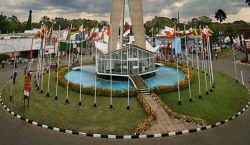

ZIMBABWE’S chrome sector is set for a rebound this year due to a surge in demand for the mineral on the international market and firming prices.
This comes on the backcloth of a re-introduction of a total ban of chrome ore exports to capacitate and protect local smelters and maximise on the value chain.
It also comes as the country, which has the world’s second largest chrome reserves at 12 percent, failed last year to exploit the natural resource due to the Covid-19 pandemic that forced ferrochrome producers to switch off furnaces following a drop in international prices.
Chairman of the Association of Ferrochrome Producers (AFP) in Zimbabwe, John Musekiwa, said demand and price for chrome were on the increase after the market suffered a shortage last year, as a result of the impact of the coronavirus outbreak.
This comes as the oversupply of chrome between 2017 and 2019 resulted in prices plummeting.
“As demand is expected to remain strong for the rest of 2021, it is expected that prices should remain supported for this year and maintain levels that will ensure viability for the global ferrochrome industry, inclusive of Zimbabwe,” Musekiwa told The Financial Gazette this week.

 Prices for low grade chrome ore (UG2) have increased by 22 percent from US$131/metric tonne (mt) CIF (cost insurance and freight) to US$160/mt.
Prices for low grade chrome ore (UG2) have increased by 22 percent from US$131/metric tonne (mt) CIF (cost insurance and freight) to US$160/mt.
Musekiwa said while prices were now firm, the logistics costs to deliver the ferrochrome to global markets had also increased sharply. He said while Covid-19 impacted demand significantly, the pandemic resulted in production costs going down, largely in the form of oil prices and freight rates.
“Supply was cut down in tandem with demand as regional lockdowns to mitigate the impacts of the Covid-19 pandemic suspended operations in the first quarter of 2020 in China and in the second quarter 2020 in the rest of the world. Towards the end of 2020, prices started to tick upwards as demand from stainless steel mills recovered globally.
“This was spurred by restocking across the supply chain, but more importantly, underpinned by a surge in production costs, most notably freight rates, which impact the main trade flow between South African mines and Chinese smelters,” Musekiwa further told The Financial Gazette.
Finance minister Mthuli Ncube said chrome prices were expected to remain firm and better than the previous year — riding on shortages created by the second and third waves of Covid-19.
The Chamber of Mines of Zimbabwe is anticipating chrome ore output of around 1,6 million tonnes this year.
This comes after a decline in production for the third year in a row — to 1,2 million tonnes in 2020, from 1,7 million tonnes in 2019 — on the back of challenges in the global stainless steel markets, according to data from the Chamber of Mines.
 Ferrochrome production declined by 50 percent to 161 657 tonnes in 2020 and Zimasco continued to be the largest player in the industry, accounting for 48 percent of chrome ore and 33 percent of high carbon ferrochrome.
Ferrochrome production declined by 50 percent to 161 657 tonnes in 2020 and Zimasco continued to be the largest player in the industry, accounting for 48 percent of chrome ore and 33 percent of high carbon ferrochrome.
Chrome Miners Association (CMA) president Shelton Lucas said the rising global chrome prices were a boon for local small-scale miners currently reeling from high production costs.
“The cost of extraction against the selling price doesn’t tally,” he said.
Zimbabwe has six ferrochrome processing plants and the government wants to increase these to 11 by 2025 to maximise mineral beneficiation.
Mines minister Winston Chitando recently told an annual mining conference that the operationalisation of two additional smelters at Afrochine and Zimasco would boost chrome and ferrochrome production this year.
“Furthermore, ZimAlloys have completed refurbishment of their furnaces. We hope with continued efforts to facilitate setting up of more smelting facilities of chrome, together with other ingredient minerals such as iron, nickel and manganese can be locally value added into steel.
“This can then contribute to bringing in more revenue to the nation,” Chitando said.
Afrochine, Amazon, Best Trade, Jin An, Monachrome and Tsingshang were granted chrome claims to boost production.
Tsingshan Group of China is already exploring for iron ore, with the aim of setting up a steel plant in the country, according to Chitando.
Zimbabwe Zhongxin Smelting Company is currently constructing a US$70 million chrome smelting plant, which is expected to produce more than 50 000 tonnes of chrome per annum.
Jinan Corporation is also planning to construct four more furnaces at its Almid plant, to increase its annual export earnings to US$100 million.
newsdesk@fingaz.co.zw